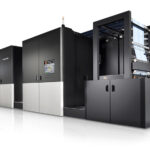High quality flat-top-dot platemaking with conventional photopolymer plates for flexography and letterpress. Acus proposal.
Acus introduces Star Plate, a professional film imaging solution based on inkjet printing that is able to reproduce the finest graphic elements with highest accuracy, without photographic process, without film imagesetter and processor and without chemicals.
Star Plate produces high resolution nano-matt films that are suitable for photopolymer platemaking, re-usable and scratch resistant. The system is able to output high density black (>D 4.0) as well as crisp and clean transparent areas to allow the reproduction of finest details up to 1% at 175 lpi (70 l/cm).
Star Plate was conceived bearing in mind the needs of photopolymer platemaking and it includes specific tools for calibration and dot gain compensation management.
Star Plate integrates Smart Screen, the award winning flexo screening technology for flexography and letterpress, that is able to optimize the tonal range, especially in high-lights. Using Smart Screen on Star Plate, thanks to a proprietary algorithm, allows the reproduction of very detailed and controlled dot shapes, with “fade-to-zero” vignettes on conventional photopolymer plates.

This screening is smart
One of the recurring challenges in flexographic printing is the correct handling of minimum printable dot on plate, especially in correspondence with vignettes fading to zero where often we find hard thresholds on highlights.
The smallest dot that can be reproduced on a flexo plate might be as small as 15-20 micron (ie 1% at 60-70 l/cm); however, once inked and pressed on substrate, this dot-on-plate would produce a printed dot of approximately 60-70 micron diameter (ie 10-15% at 60 l/cm) or more. Although latest digital platemaking technologies allow the reproduction of very small dots, these printing elements might dip into anilox cells and get ink on shoulder which will create a gain in printed area. For this reason it is better to increase the plate dot size rather than decrease it, and this can be done only with lower screen count on plate or alternatively use a hybrid screen in highlights.
Generally hybrid screen is preferred, although sometimes it introduces some grainy noise on print: Smart Screen was specifically developed for the needs of flexo and letterpress platemaking, and it allows very smooth vignettes without noisy or dirty print. Smart Screen is also available in RIP version for the production of 1bitTiffs files ready for imaging onto any existing flexo CtP at 2400, 2540, 400 or 4800 dpi resolution.














